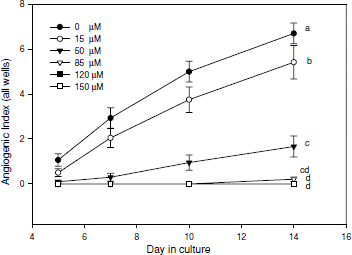Figures & data
Table 1. Effect of different solvent extraction regimes on curcumin concentrations ± one standard error (SE) in respectively prepared turmeric extracts (n = 5). Curcumin yield is a product of average turmeric extract weight and its curcumin concentration. Different letters following each value represent a significant difference at P ≤ 0.05 based on adjusted Tukey-Kramer Least Square Means tests.
Figure 1. Angiogenic responses to curcumin in pure form at various concentrations. Vertical bars across each data point represent one standard error of the mean (n = 73 to 120). Different letters (a, b, c, d) at the end of each line represent a significant difference of an average response over days at P ≤ 0.05 based on adjusted Tukey-Kramer Least Square Means tests. Angiogenic Index is a reflection of angiogenic responses in all test wells and scores can range from zero to sixteen.

Figure 2. Angiogenic responses to curcumin (μ M) in the form of turmeric extracts (μ g/ml) at various concentrations in parenthesis. Vertical bars across each data point represent one standard error of the mean (n = 73 to 120). Different letters (a, b, c, d) at the end of each line represent a significant difference of average response over days at P ≤ 0.05 based on adjusted Tukey-Kramer Least Square Means tests. Angiogenic Index is a reflection of angiogenic responses in all test wells and scores can range from zero to sixteen.
